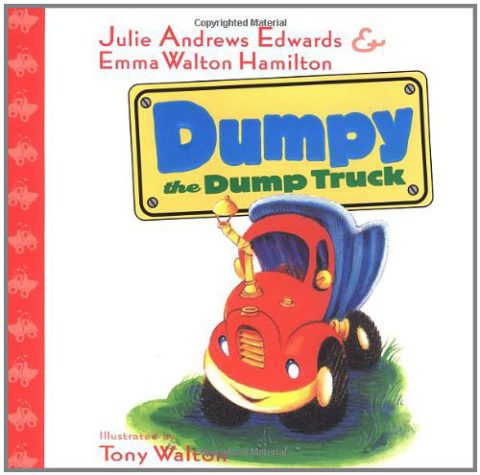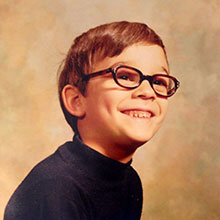Originally published in The New York Times
The Roads Are Alive
Trucks are the subjects of two new picture books; one with Julie Andrews as author.
 ot so long ago, hearing a ”Beep! Beep! Beep!” sound in the vicinity of a 5-year-old, one assumed that the child was cheerfully imitating a motor vehicle, not honing his incipient mutant-killing abilities on a digital gizmo.
ot so long ago, hearing a ”Beep! Beep! Beep!” sound in the vicinity of a 5-year-old, one assumed that the child was cheerfully imitating a motor vehicle, not honing his incipient mutant-killing abilities on a digital gizmo.
Two picture books, ”Dumpy the Dump Truck” and ”Big Truck and Little Truck,” brightly roll against the traffic flow of contemporary kid stuff with earnest, old-fashioned charm. Both tales combine smiley anthropomorphized automobiles (think Herbie, the Love Bug) with gentle endorsements of kindness to elders and optimistic self-confidence (think ”The Little Engine That Could”).
 Julie Andrews Edwards, Emma Walton Hamilton and Jan Carr do youngsters and parents a favor by maintaining a welcome light-handedness in their unarguably sensible moral undertones. Sweetness is baked into these stories, not slathered on in the icky-sticky purple icing of Barneyism. The prose in both books is clear, not singsong. There are no catch phrases here. Simplicity and substance carry the day.
Julie Andrews Edwards, Emma Walton Hamilton and Jan Carr do youngsters and parents a favor by maintaining a welcome light-handedness in their unarguably sensible moral undertones. Sweetness is baked into these stories, not slathered on in the icky-sticky purple icing of Barneyism. The prose in both books is clear, not singsong. There are no catch phrases here. Simplicity and substance carry the day.
The watercolor and colored-pencil images in both books are also simple, a bit too much so in the Broadway set and costume designer Tony Walton’s largest illustrations for ”Dumpy,” which suffer from backgrounds that feel hasty and unfinished. Walton’s work generally lacks the richness of light and depth that give Ivan Bates’s roadside rural landscapes and characters in ”Big Truck” an engaging vividness.
With motion lines, shifting tones indicating multiple lanes of traffic, and splotchy puffs of exhaust, Bates’s image of youthful Little Truck caught in his first solo traffic jam is imbued with a real sense of anxiety. Young readers will immediately understand why the usually jaunty yellow pickup now has downcast headlights and a fretful expression on his grille.
”Big Truck and Little Truck” has just enough subtle detail in its illustrations, and enough psychological nuance in its storytelling, that early-grade schoolchildren will be sufficiently engaged to read it on their own. A soothing parable about overcoming separation anxiety, it would make an ideal gift for a child about to stay behind while his parents go away, say, on vacation. In such a situation, the absorbing old-fashioned comforts of a relevant picture book can undoubtedly work better magic than the beep-beep of fleeting electronic distractions.
While Carr and Bates have created a lovely tale of independence that children can read on their own, Andrews, Hamilton and Walton offer a story of collaboration between and an adult and a child — Charlie and his grandfather restore an out-of-commission dump truck to help erect a new barn — that will best be enjoyed in a collaborative, read-aloud situation.
Dumpy’s exclamations of ”BEEP! BEEP! BEEP!,” Stinky the Garbage Truck’s ”ERR-RNN!” and Ike the Ice Cream Truck’s ”DING-A-LING-A-LING!” are set in cartoonish, capitalized type, which stands out from the rest of the story’s text and begs to be enunciated with verbal flourishes by parents, then identified with the appropriate character illustrations and imitated by children. Given the book’s best-known author — yes, it’s that Julie Andrews — it’s hard not to imagine a brood of lederhosen-clad kids enthusiastically substituting ”Brrrroooooom! Hissssssssss! Clang!” for ”Do, re, mi.”
It should be noted (fa!) that Andrews is not just jumping on the celebrity kids’-book dump truck — er, bandwagon — here. The duly celebrated star of ”Mary Poppins” and ”The Sound of Music” has written both chapter and picture books over three decades, most memorably the fantasy adventure ”The Last of the Really Great Whangdoodles.”
It is also worth pointing out that although three women wrote these truck stories, none of the featured human characters are female. Many of the old-fashioned aspects of these books are warm and welcome, but its a shame to find that old-fashioned gender stereotypes keep on truckin’.
